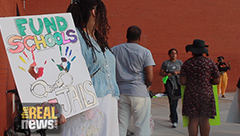The school board says that Langston Hughes Elementary School (at a total enrollment of 176) is too small, and that: "declines in enrollment make it difficult to support and maintain robust programming." (Baltimore City School Closure and Relocation Report) In fact, small size has been the only consistent reason given by school system administrators for closing Langston Hughes, a reasonably successful and well-respected school in a struggling, low-income black neighborhood in Northwest Baltimore. But a quick review of the 10 smallest schools in Baltimore (not including schools for students with disabilities) shows a disturbing pattern. Four of the 10 smallest schools—the ones that serve almost entirely (over 90%) African American students--are slated for closure. The four schools that serve a disproportionate percentage (over 40%) of White students (compared with the 15% of white students in the school system) are all staying open. The same pattern emerges if you broaden the study to include more small schools.
The mass rally and lock-in that took place last Friday outside and inside the school was the the sixth action in an on-going battle to save the school. Neighborhood leaders and local supporters are bringing attention to the fact that this is a good school in a well-maintained building with great support from the community. They are questioning why the school board would close a good school. “Langston Hughes is a gem!” says George Mitchell from the Langston Hughes Community Action Association. He points out that the school students will be sent to, if the threat of closure is realized, is Pimlico Elementary/Middle—a school located a mile away, across a major street, and surrounded by a particularly run-down section of the community where abandoned homes, drug dealing, dirt bikes, tall weeds and trash are rampant. The five previous community protests have all involved adults and children taking the same walk to be taken by students as young as 4 and 5 years old each day. At recent school board meetings Mr. Mitchell and other community leaders have challenged the school board members to come “do the walk.” So far they have all declined. Parents, community members and supporters from other parts of the city who have taken the walk have all been outraged at the prospect of sending students through these streets to a school where there are already rumors of violent threats against the “new kids.” Pimlico is the worst performing school in the Park Heights community and has issues of over-crowding, poor building conditions, and high teacher turnover. The school is slated for renovation over the next several years which parents believe will make the overcrowding and health issues even worse.
So local leaders are asking the question: “Why, in a city where all eyes are on the underlying causes of our recent unrest, are we threatening to close a school such as Langston Hughes?” Why would we close any small, safe and relatively successful school, particularly if it is located in a low income, Black neighborhood and serves as a vital anchor-institution? If the only reason is that the schools are “too small,” and therefore “inefficient,” how is it that equally small schools serving whiter, more middle class populations get to stay open? One reason, they believe, is that these whiter, more middle class schools are charter schools and enjoy a relatively protected status and more flexible budget: Montessori Middle (88 enrolled; 42% White; 39% FARMS—Free and Reduced Meals); Independence School Local 1 (127 enrolled; 41% White; 68% FARMS); Green School (150 enrolled; 45% White; 27% FARMS), City Neighbors Charter School (216 enrolled; 43% White; 38% FARMS). We see small schools that are free from threat of closure and able to provide exactly the kind of programming that makes sense for the families whose children attend them. Three of these schools serve fewer students than Langston Hughes where attendance been lower in recent years due primarily to the threat of closure and competition from nearby charter schools.
A comparison between a small Black school such as Langston Hughes and these other small schools immediately reveals two facts: Small schools are often safer, more caring, and more likely to produce good academic results for children who might otherwise not succeed in a larger setting (such as Pimlico Elementary/Middle)—a fact that appeals equally to low income and middle income parents. The second fact is that the charter schools receive more of their funding in cash out payments ($9450 for charters compared to approximately $6800 for Langston Hughes when compared line by budget line). Charter funding allows schools to voluntarily forgo services from central office in order to provide small class sizes and distinctive programming. The City Schools budget document for school year 2015-2016 includes this note on small schools: “At the school level, below a certain enrollment, it becomes difficult to provide an adequate standard of care, and things like after-school programming or maintaining a school library may be threatened. That’s why, for FY16, City Schools supplemented the budgets of 19 small schools with an additional $2.2 million.” If Langston Hughes were to convert to charter status it would receive approximately $400,000 more than it does now without any additional “subsidy” from the school system. Leaving aside whether charter schools actually cost the school system more than neighborhood schools, and leaving aside the even more important issue of lack of truly adequate funding for all our city schools, it is undeniable that some parents in mostly White neighborhoods have the option of sending their children to small schools that have the freedom to allocate funds as they see fit to meet their student needs. Black students from a low-income neighborhood in Northwest Baltimore are being denied this option.
Websites and Facebook Pages for more information:
Langston Hughes Community Action Committee https://www.facebook.com/langstonhughescommunityactionassociation?fref=ts
Teachers’ Democracy Project
www.TDPBaltimore.org
Baltimore Algebra Project
www.Baltimorealgebraproject.org
Baltimore City Schools FY16 Budget
http://www.baltimorecityschools.org/cms/lib/MD01001351/Centricity/domain/8052/pdf/FY16-ProposedBudget.pdf
Baltimore City Schools Closure Report
http://www.baltimorecityschools.org/cms/lib/MD01001351/Centricity/Domain/8057/20150226-ClosureRelocationSurplusReport-FINAL.pdf
Summary of “Portfolio Recommendations and Decisions”
http://www.baltimorecityschools.org/Page/27217
 open. Director of Teachers' Democracy Project (TDP), Helen Atkinson, was also interviewed and shares her support for LHES highlighting the disparities in the selection of schools slated to close as well as how small schools like LHES are anchors for residents.
View the full video and transcript by TRNN here.
open. Director of Teachers' Democracy Project (TDP), Helen Atkinson, was also interviewed and shares her support for LHES highlighting the disparities in the selection of schools slated to close as well as how small schools like LHES are anchors for residents.
View the full video and transcript by TRNN here.
